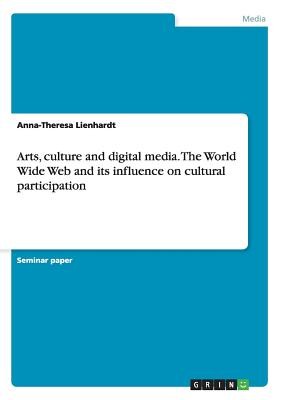
- Mēs nosūtīsim 10-14 darba dienu laikā.
- Autors: Anna-Theresa Lienhardt
- Izdevējs GRIN Verlag
- Gads: 2014
- Lapas: 24
- ISBN-10 : 3656740712
- ISBN-13 : 9783656740711
- Formāts: 14.8 x 21 x 0.2 cm, minkšti viršeliai
- Valoda: Anglų
- Extra -10% atlaide, ievadot kodu: EXTRA
Arts, culture and digital media. The World Wide Web and its influence on cultural participation + bezmaksas piegāde! | Bookbook.lv
Atsauksmes
Apraksts
Seminar paper from the year 2013 in the subject Art - Computer Art / Graphics / Art in Media, grade: 8, Maastricht University, language: English, abstract: The new opportunities humanity gets while society develops and technology grows are seemingly non-terminating. Obviously, many people like to benefit from the arising advantages and the positive side-effects. The World Wide Web is one of these technologies, that on the one hand remarkably facilitate our life and on the other hand lead to a more complex and intertwined system and to changes that can not be reversed. In times of rapid growing technological progress civilization struggles with the issue of striking new paths to the future while at the same time fostering the own cultural heritage. For some people arts and culture are necessary, because they belong to their roots and are signs of their history, but opinions and notions about that theme vary widely. Still there are hotly debated problems relating to cultural policy - Heilbrun & Gray (2011) argue that arts and culture are caught in a materialistic world (p. 3) which is the reason why they always have to deal with a mighty term called 'money'. But when thinking about culture and heritage, it is not just about keeping the past in mind and preserving ancient monuments. It is also about actively promoting the arts and culture, that currently come into existence. Technologies arise and so do arts. How to cope now with balancing between past and future, heritage and progress, art and high-tech? Bringing something forward means spending time on it, participating in it and therefore reinforcing it. A modern world needs people who get involved and that is why participation may be one of the pivotal things needed for generating a successful future. By taking a look at the current situation, I want to examine the special relationship between the use of the internet and participation in arts and culture. What do we understand by thinking of the term 'cultural10 EXTRA % atlaide
Kupona kods: EXTRA
Akcija beidzas 7d.06:07:02
Atlaides kods derīgs pirkumiem no 10 €. Atlaides nav kumulatīvas.
Derīgs tikai pirkumiem tiešsaistē.

- Autors: Anna-Theresa Lienhardt
- Izdevējs GRIN Verlag
- Gads: 2014
- Lapas: 24
- ISBN-10: 3656740712
- ISBN-13: 9783656740711
- Formāts 14.8 x 21 x 0.2 cm, minkšti viršeliai
- Valoda: Anglų

Atsauksmes